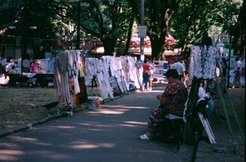Project 2: Comparing Rural Property Relations in Bulgaria and Ukraine
Project 2: Comparing Rural Property Relations in Bulgaria and Ukraine

A comparison with my Bulgarian fieldsite, only 400 km south of the Ukraine site, suggests several contrasts. The criteria used to allocate land have significantly shaped new forms of agricultural production and related problems. In Ukraine (and this is true for most of the former Soviet Union ) land reforms have been carried out on the basis of the type of work performed during the socialist period and land use entitlement. In Bulgaria , restitution to pre-1944 owners has been the main criteria. In both cases, this has led to a renewed importance of kinship, although in quite different ways. But in the Bulgarian case it has also openly polarised the country, creating historically rooted political divisions between the rural and urban areas (see CV for various publications on this topic). In Ukraine an increasing number of individuals are taking their land out of the cooperatives in order to work it together with the land of other family members and friends. This is partly in response to the disappointing rent that the successor and still dominant cooperatives offer. But it differs considerably from the Bulgarian case where demographic factors (high elderly population in rural areas), as well as greater historical and ideological commitment to cooperative forms of farming, contribute to the lack of small, household based farming groups. Further, reforms in Ukraine have been more drawn out - partly as a result of greater resistance to them at the national and regional levels. This has meant that, locally at least, the same figures who were powerful during socialist times still retain power. In the Bulgarian context a notable shift in local power relations is evident (see Who Owns the Past? 2004). Lastly, reforms in Ukraine have been more wide reaching in the respect that they include the privatisation of various resources - water, some housing and so on. This was not the case in Bulgaria where the socialist cooperatives never had such vast control over local life in the first place.
This last point alerted me to the need to look at property from a broader perspective. Land, though important, was not the only resource at the centre of Ukraine village reforms and changing ideas about property. In the case of water, control has moved from the kolkhoz and sovkhoz to the village municipal council. Occurring in parallel with a growing dependency on household production, this has created a new source of local tension. In recent years the survival of the household depends on plot production, unlike the Soviet period when villagers bought most of their fruit, vegetables and meat at subsidised rates from the kolkhoz and sovkhoz. The new importance of water arises from this increased tending of household plots and has resulted in squabbles between neighbours and between different areas of the village with unequal access to water. Less tangible ‘properties’ are also under negotiation. The cosmological order, for example, is a battleground as the newly prominent Orthodox priest struggles to regain control over the moral domains of village life after 50 years of socialism. ‘Culture’ can also be viewed as a form of property that is being renegotiated in the context of the newly emerging independent Ukraine state – here it is local identity which is the resource under review. The village at the centre of my Ukrainian research is ethnically Bulgarian, and yet many inhabitants embroidered Ukrainian cultural objects at the local sewing centre. Handicrafts are an important marker of identity. Through the production of Ukrainian style embroidered objects, villagers carved out a new position for themselves vis-à-vis the newly emerging independent state, as Ukrainian citizens with minority group status.
